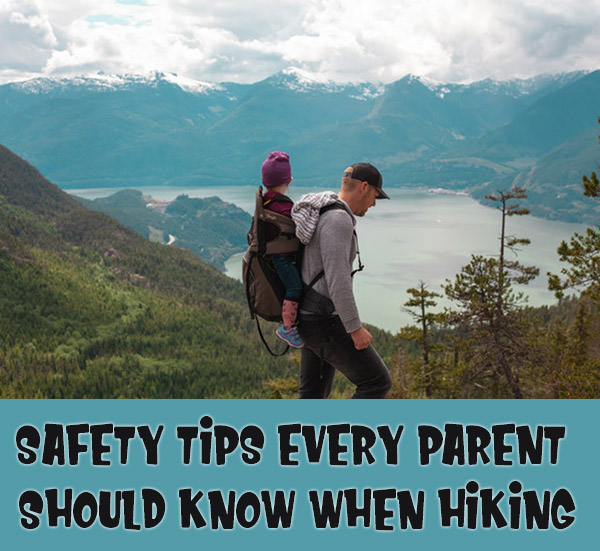They say that “it’s about the journey, not the destination.” Natural beauty is best accessed on foot. And when you go hiking with your family, it becomes more than just the surrounding views. Reaching the end of the trail is the goal, but it’s not the only one to keep in mind—spending quality time together and having memorable and shared experiences in the outdoors matter more.

The slow and steady countryside is always a welcoming respite from the unceasing city life. Exploring the living greenness and getting lost in the wild are some of the ultimate adventures you’ll ever have in a lifetime. When you’re single and free from obligation, the great outdoors, through the valley and beyond, is your oyster. It gradually changes when you start sharing your life with someone and building your own family.
But having children doesn’t mean you can’t have adventures anymore. It gets better because now you’ll have mini-yous to share the outside world with. Nothing should stop you from hitting the mountains and responding to Mother Nature’s beck and call.
Sure, there are more factors to consider when planning a hike. Where should you go? How long should you stay? Will they enjoy the trip? You’ll have to answer these questions before embarking on an adventure.
You can expect every day spent in the outdoors to be different when you’re with kids. You’ll have to adjust your plans and make them adaptable for your children, rather than expect them to be flexible to yours.
Being out in the wild will make you feel grounded and connected to the people you’re with like nothing else can. The sense of wonder from children is infectious. Watching your kids interacting with the natural environment and growing to love them are things you shouldn’t miss. Taking one step after the other is a moving meditation and doing them with the people you love solidifies the bond that you have, even more. You’ll be surprised with the quality of conversations and questions that’ll come up given the time and calm sanctuary surrounding you. For you and your loved ones to hit the ground running, here are the things you need to know and prepare for to keep you and your kiddos safe on the track:
Lead the way and always carry extra light with you
Set the ground rules at the onset. Every hike is a learning opportunity, and your kids should have this kind of mindset. You probably went through your learning curve as a solo adventurist. You know what you need and what you don’t from your previous hike experiences.
But this time it’s different because you’ll be learning about your kids and how they behave outside the comforts of your home. It will be a learning activity both for you and your children.
And because you are all you have out there and they’ll depend on you solely, so make the trip as safe as possible.
Unexpected situations tend to come up while you’re deep in the greens. It’s better to choose a trail that you’ve been in before—the familiar is always the safer choice. Nature is full of surprises even if you’ve been on the same track before. Which is why it’s essential to do your research and double-check every turn and every trail. See if there has been any changes since the last time you went there. Do all these before heading out.
It will be fun to let the kids get involved in the planning process. But, as a parent, the baseline stuff should be mapped out by you first. Study the route you’ll be exploring and make sure that the trail is not only fun, but it is entirely safe and kid-friendly. Go through trailmaps thoroughly to make sure it’s appropriate for the whole family. A steady and flowing stream with modest habitation on the side is dandy, but a raging white river with equally ravenous-looking ravines—not so much. Be sure there are places to stop for shade or cover in case the weather conditions change from sunny to rainy.
When you’re hiking with young kids, make sure the slopes are smooth, and the ascending terrains are gradual. Avoid steep drop-off points and slippery surfaces. Regardless of what path you take, start early and keep track of time so you’re not hiking back in the dark. And just in case, pack headlamps.
Bring loads of food and water, more than what you think you need
The feeling of uncertainty, too, can be re-channeled as a safety measure. When you know what to expect and allow a little elbow room for the unexpected, you’ll have a good idea on which to pack and bring more of to have a good outing.
Weather forecasts are usually spot-on, but there are instances when sudden surges in temperatures happen. With a tot in tow, anything can happen given their boundless energy and fresh perspectives. Things can get pretty crazy very quickly. And because they’ll exhaust loads of energy, they’ll end up getting hungry very quickly. Pack healthy and crunchy snacks so they can munch on them while walking. If they get too hungry, they may end up wanting to stop hiking, which is why it’s important to bring snacks so that they can burn them off and feel full most of the time.
High-protein bars are top choices for kids. Peanut butter and jelly sandwiches, dried nuts, and fruits, cheese sticks—these are some of their favorite stuff to snack on. Surprising them with a treat here and there can also boost up their motivation. Try not to feed them too many sugary snacks as they might end up feeling sluggish during the walk. But do give them one or two now and then to reward good behavior—especially at the end of the trail.
As for water, follow the reversed principle of less is more. Bring plenty of water, more than you think you’ll be needing. For a regular-sized hiker, you’ll need at least a liter per kilometer. For the little-sized ones, you’ll probably need more as they are not used to walking in long distances. They have less control over their water intake so they’d probably drink more than they should. Hence, bring loads of it, as much as you can carry.
Teach them the steps to take when they get in trouble
You can never know for sure what you’ll encounter out in the woods. It is, after all, home to several wild creatures that may or may not be friendly to both little and average-sized humans. The chance of getting attacked by a curious animal is always there. That’s why it’s crucial to wear trail gear that can improve visibility. In their backpacks, make sure they each have first-aid kits and know how to put a band-aid if they need to. When selecting a kit for such occasions, it can be important to choose one that is not only comprehensive but can also withstand the rigors of a road trip. Opting for a durable, water resistant, and dustproof option can ensure that essential medical supplies can remain protected, regardless of the weather or terrain. Making sure that these robust medical kits australia, or from elsewhere, can be readily accessible and reliable can make all the difference in handling emergencies successfully.
Furthermore, plants and bushes can be equally troublesome as lurking animals. Your kid might have unknown allergies to them. Even an innocent twig lying around can sometimes cause injuries, too, if you’re not too careful. Sometimes danger can happen even in safe places.
With that in mind, always make them wear a whistle and teach them how to blow it if they are in any trouble. If they fall behind or may not know or see where you are, they can use the whistle as an SOS. Having at least two or three accompanying adults for three to four hiking kids should be fine.
Also, out in the wild, is a completely different atmosphere compared to your home-it’s much broader and bigger. You may have the habit of keeping an eye on your kid when at home, but most parents underestimate the vastness of the outdoors. It’s not uncommon for parents to make mistakes out in the open. But try always to keep you’re your kids in front of you where you can see them. Children can just as easily get lost in the marked trail as they would in a supermarket. Though there are signs everywhere, these won’t register with they’re under pressure or realize they’re lost. Having more adults means having more eyes to watch the kids. When one adult gets injured in any way, the two can go back for help, and the other one can stay with the injured person and the kids.
Work with your kids’ pacing
As a parent, always recognize the fine line between pushing your kids a little bit so that they learn, and pushing them too much that they’re no longer want to be where you are. Unless your children are nearing their teens, don’t force them too hard to keep pace with you. Allow them to set the pace.
Most kids love the outdoors as soon as they start walking the path. The sense of freedom amid vastness is an incredible feeling for them, and they get excited because of it. But some kids don’t feel that way immediately. You have to let them ease into it. Don’t get discouraged if they seem like they’re not enjoying themselves. Love for the outdoors may come in a slow and steady stream for some instead of a waterfall.
Let them ease into the activity and adjust with baby steps. When they’ve started warming up to it, then plan for hikes that include exciting features like streaming rivers or those with fauna and rock formations. Water sources are always a huge hit for children of all ages. Summertime is an excellent time for exploring and swimming in them. It’s easier to motivate kids when they have something interesting to look forward to. Take them to the outdoors as often as you can and encourage them to explore during hikes. Give them different roles in every walk to keep it interesting for them. Hiking is still one of the best teachers, not just for parents, but for children too. Guide them through the wonders of the outdoors as much as you can and make sure to give them a great time while you’re doing it.






Speak Your Mind